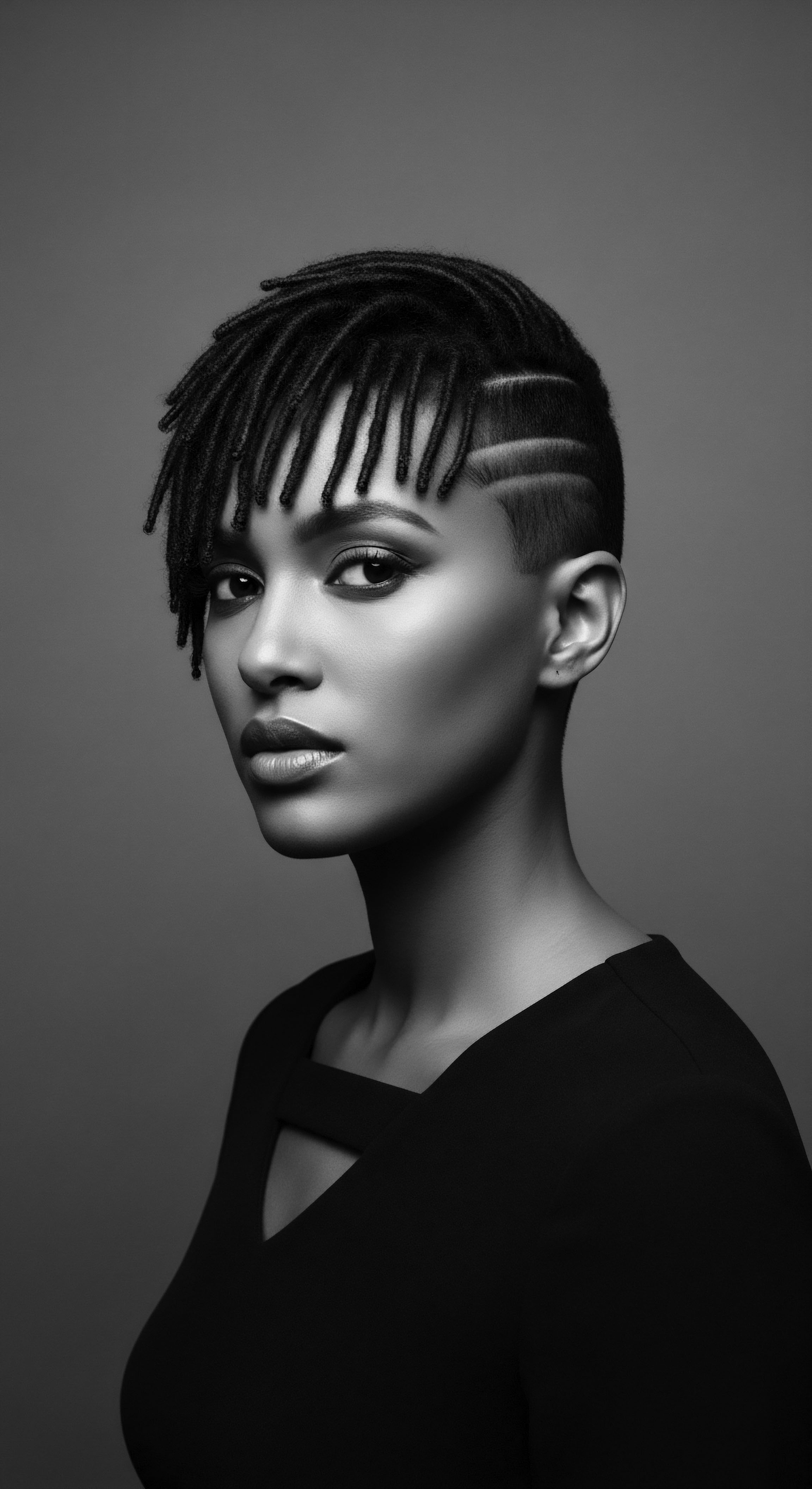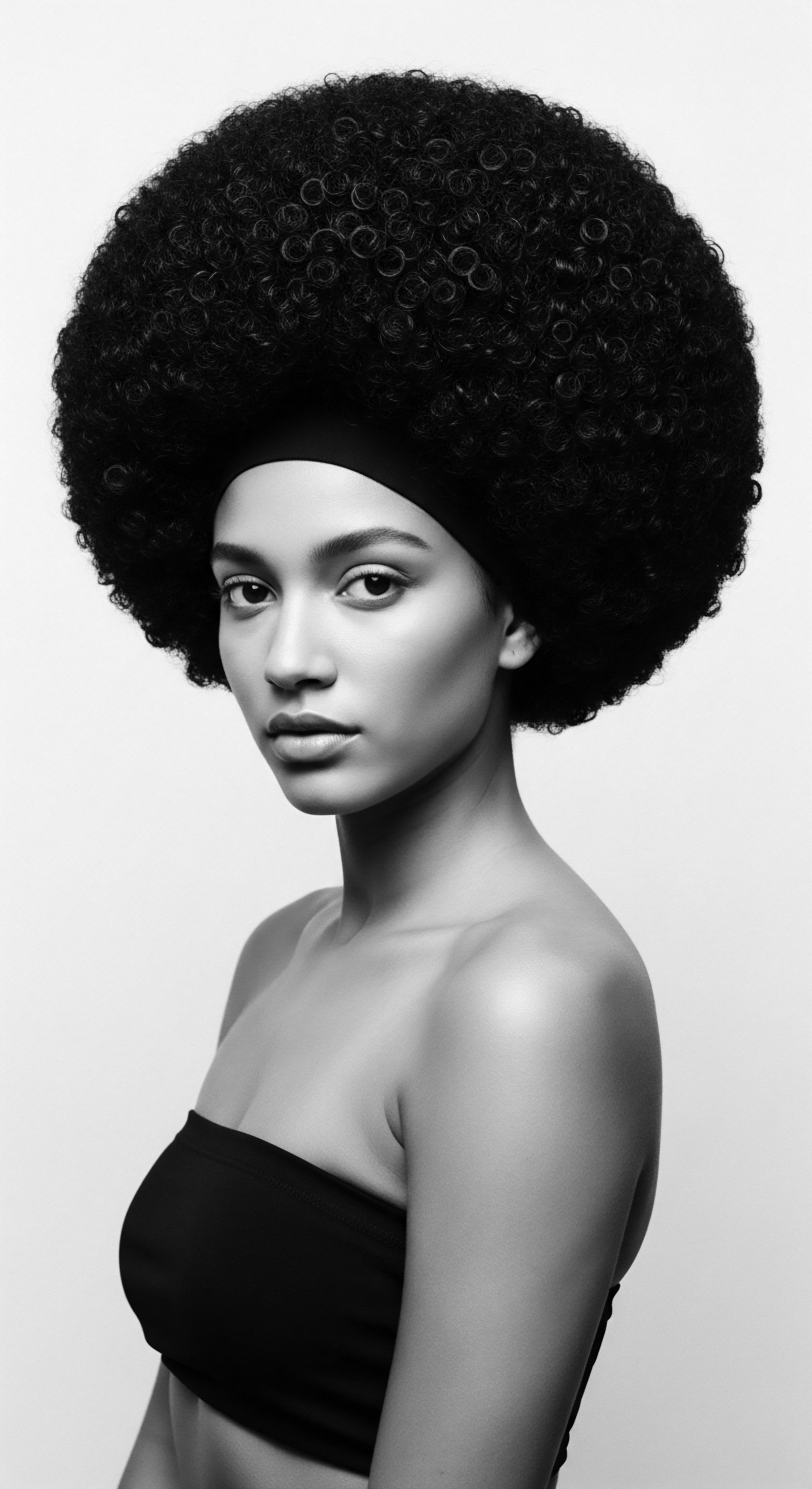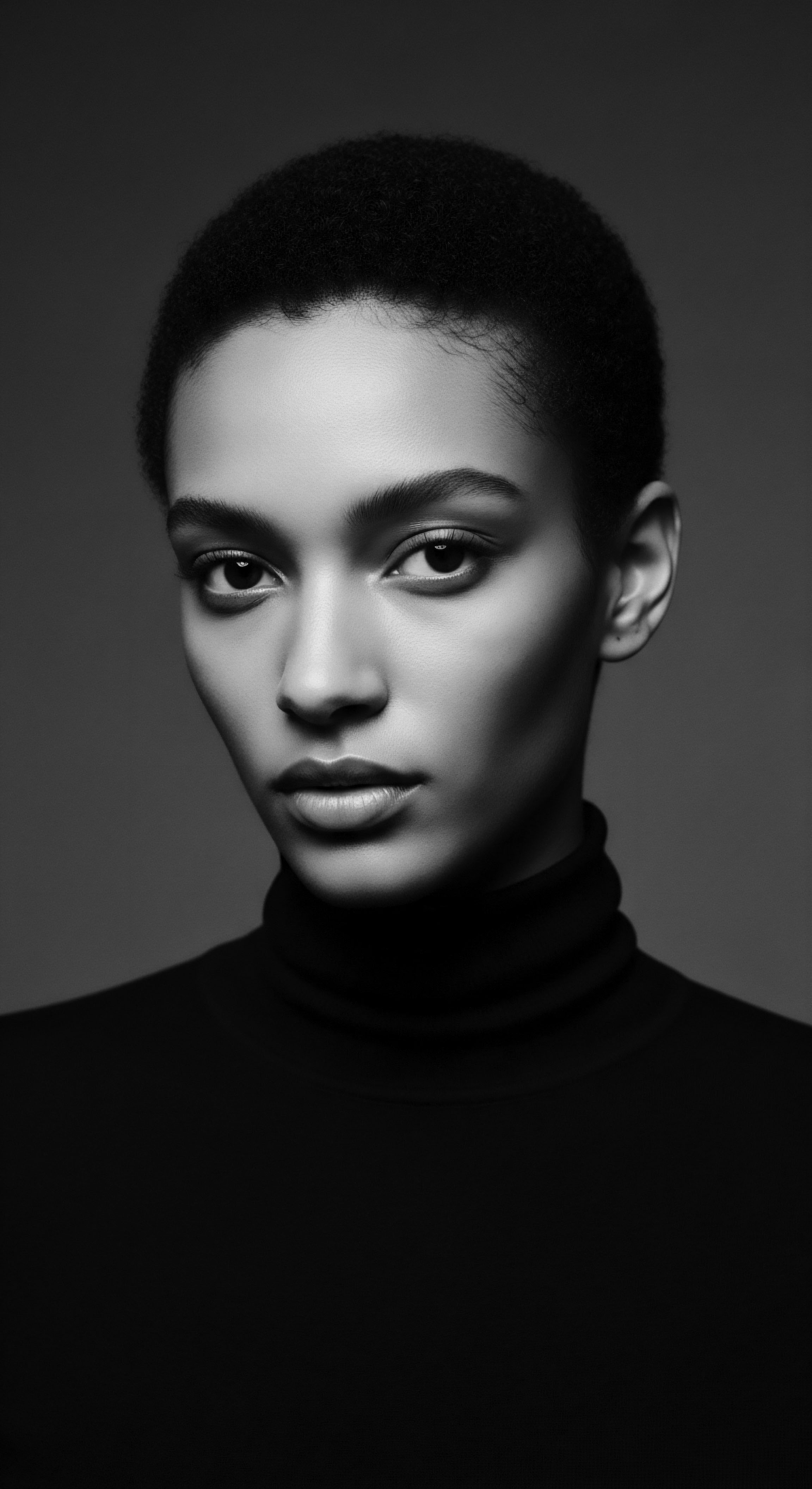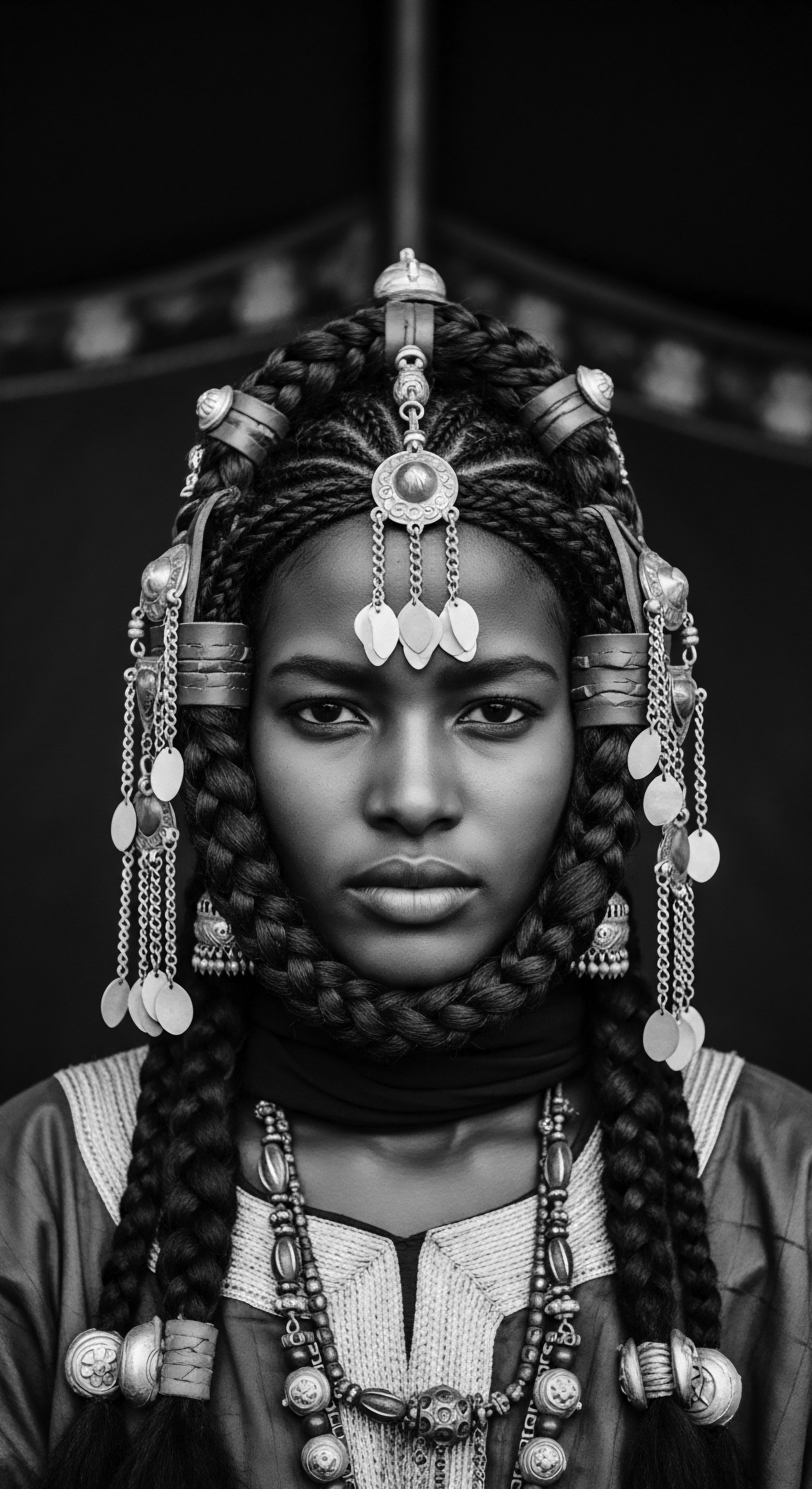
Fundamentals
The concept of Meroitic Queens Hair beckons us into an ancient realm, inviting a deeper appreciation for the enduring legacies of textured hair. At its core, this designation speaks to the distinctive coiffures, adornments, and practices associated with the royal women of the Kushite Kingdom of Meroë, a civilization that flourished in ancient Nubia (modern-day Sudan) from approximately 800 BCE to 350 CE. It represents a living archive of hair artistry, a powerful declaration of identity, and a profound connection to ancestral wisdom surrounding hair. This explanation is not merely about historical styling; it is about the inherent power and cultural resonance embedded within each strand.
The fundamental meaning of Meroitic Queens Hair extends beyond mere aesthetics. It acts as a lens through which we can perceive the spiritual, social, and political standing of these formidable women. Their hairstyles, meticulously crafted and often featuring intricate braids, coils, and extensions, were visual affirmations of their regal stature and divine connections.
These practices were a testament to the sophisticated understanding of hair care and styling that existed in this ancient African kingdom, predating many contemporary beauty rituals by millennia. The careful preservation of these styles, even in funerary contexts, speaks to the immense cultural value placed upon hair within Meroitic society, highlighting its significance as a symbol of life, vitality, and lineage.
Meroitic Queens Hair offers a profound window into the sophisticated hair artistry and cultural declarations of identity from an ancient African civilization.
In considering the basic description of Meroitic Queens Hair, one must understand its foundation in the unique properties of African textured hair. The elasticity, resilience, and natural ability of coiled hair to form intricate patterns lent itself perfectly to the elaborate styles depicted in Meroitic art and archaeological findings. These styles were not accidental; they were the result of a deep, intuitive understanding of hair’s elemental biology and its capacity for sculptural expression. The use of natural oils, clays, and perhaps plant-based dyes would have been integral to maintaining the health and structure of these elaborate arrangements, underscoring a holistic approach to hair care that resonated with the environment and its offerings.

Ancient Adornments and Techniques
The visual representations of Meroitic Queens often depict them with various forms of hair decoration. These were not simply accessories; they served as potent symbols that conveyed status, religious affiliation, and personal narratives. The techniques employed to achieve these looks were labor-intensive and collaborative, involving communal practices that deepened the bond between individuals and their shared heritage.
- Gold Hair Rings ❉ Often seen adorning braids or locs, these rings signified wealth and royal authority, capturing sunlight and reflecting the queens’ divine association.
- Beaded Filaments ❉ Strands of beads, frequently crafted from faience or precious stones, were interwoven into the hair, adding color and texture, often carrying protective or symbolic meanings.
- Headpieces and Crowns ❉ Ornate headwear, sometimes incorporating animal motifs like the uraeus (cobra) or vulture, extended the coiffure’s visual impact, symbolizing power and protection.
- Hair Extensions ❉ There is evidence suggesting the use of added hair, whether human or plant-based, to create volume and length, showcasing a sophisticated understanding of hair augmentation techniques.
The daily maintenance of such styles would have involved rituals of care passed down through generations, a testament to the enduring traditions of hair grooming in African societies. These practices were not just about cleanliness; they were sacred acts, connecting the wearer to their ancestors and to the very spirit of the land. The heritage of Meroitic Queens Hair, even in its most fundamental explanation, urges us to acknowledge the profound depth and meaning woven into the strands of textured hair across time.

Intermediate
Building upon the foundational understanding, the intermediate description of Meroitic Queens Hair delves into its deeper cultural and historical implications. This concept represents a complex interplay of aesthetic choice, societal structure, and ancestral reverence within the ancient Kingdom of Kush. The hair of these queens was a dynamic medium, conveying messages that transcended spoken language, speaking to the intricate web of identity and power in a thriving civilization. This comprehensive interpretation acknowledges the profound significance these styles held, not as isolated fashion statements, but as integral components of a rich cultural tapestry.
The significance of Meroitic Queens Hair, viewed through an intermediate lens, expands to encompass its role in expressing the unique dual heritage of Kush. The Meroitic civilization, positioned between Egypt and the heart of Africa, absorbed influences while maintaining its distinct identity. Their hairstyles often reflected this synthesis, displaying both indigenous African forms, like tightly coiled styles and intricate braiding, alongside elements that might have resonated with Egyptian iconography, albeit distinctly reinterpreted.
This blending of influences allowed for a unique aesthetic vocabulary, where hair became a canvas for cultural negotiation and assertion, clearly designating their own distinct power and autonomy. The nuanced interpretation of these styles offers insights into the cultural exchange and political landscape of the ancient world.
The nuanced expression of Meroitic Queens Hair serves as a dynamic record of cultural synthesis and sovereign assertion in ancient Kush.

Hair as a Socio-Political Statement
The coiffures of the Meroitic Queens were rarely static; they evolved, sometimes reflecting changes in political alliances, religious beliefs, or even the reigning queen’s personal lineage. For example, some depictions show styles reminiscent of the elaborate wigs seen in Egyptian royalty, yet executed with an unmistakably Meroitic flair, emphasizing the natural texture and resilience of the hair itself. This adaptability highlights a strategic engagement with hair as a powerful tool for diplomacy and internal messaging. The distinctiveness of Meroitic hair practices, even when borrowing forms, always maintained a core authenticity rooted in African hair traditions, setting them apart from their northern neighbors.
Consider the role of the Kandakes, the powerful warrior queens of Meroë. Their often fierce and regal portrayals, complete with elaborate coiffures, served to project an image of formidable leadership and divine protection. The visual grandeur of their hair amplified their authority, underscoring their capacity to rule and defend their kingdom.
This visual rhetoric, embedded in their hair, reinforced their societal standing and conveyed strength to both their subjects and potential adversaries. The choice of specific adornments, the height of a crown, or the length of a braid, all contributed to this calculated projection of power and majesty.
The knowledge required to maintain and style these elaborate coiffures was likely passed down through generations of skilled practitioners, women who held positions of respect within the royal court. These hair artisans understood not only the aesthetic principles but also the biological properties of textured hair, employing traditional ingredients and techniques that maintained hair health. Their practices were an intricate part of the cultural economy, preserving a unique form of knowledge rooted in ancestral practices. The care provided was a communal endeavor, a ritual of connection that reinforced social bonds and celebrated shared heritage.
An intermediate delineation of Meroitic Queens Hair, therefore, transcends a simple chronological account. It becomes an exploration of how hair served as a repository of historical memory, a living symbol of resistance, and a dynamic canvas for cultural dialogue. It informs our contemporary understanding of textured hair as a vehicle for self-expression and cultural pride, demonstrating a continuous lineage of meaning that stretches from the ancient Nile Valley to the present day.

Academic
The academic elucidation of Meroitic Queens Hair compels a rigorous examination of its complex layers, situating it within the broader discourse of ancient African material culture, bioarchaeology, and the anthropology of aesthetics. This designation represents not merely a historical style but a profound semiotic system, a visual language employed by the queens of Meroë to articulate their sacral kingship, political agency, and a distinct cultural identity within a highly interconnected ancient world. This intellectual interpretation demands an interdisciplinary approach, drawing from archaeological findings, iconographic analysis, and the scientific examination of human remains to construct a comprehensive framework for its meaning and societal impact.
The meaning of Meroitic Queens Hair, from an academic perspective, is deeply intertwined with the specific biological characteristics of ancestral African hair textures and the ingenious methods developed to manage and adorn them. Modern scientific studies have begun to offer compelling insights into the physical properties of hair samples recovered from Meroitic archaeological sites, providing a tangible link to ancient practices. For instance, a seminal study by Solange MacLean and colleagues on hair samples obtained from individuals interred at the cemetery of Semna South, a site associated with the broader Nubian cultural sphere that preceded and overlapped with Meroitic influence, has yielded invaluable data (MacLean et al. 2012).
Their analysis of hair cross-sections and protein structures confirms the prevalence of tightly coiled, darkly pigmented hair, consistent with populations of African descent. This elemental biology underpins the unique styling possibilities and historical resilience of these hair types.
Academic inquiry into Meroitic Queens Hair unveils a sophisticated semiotic system deeply rooted in ancestral African hair biology and intricate cultural practices.

Bioarchaeological Insights and Their Significance
The work of scholars like MacLean provides a critical entry point into understanding the foundational “stuff” of Meroitic Queens Hair. Their research revealed evidence of treatments and preparations on ancient hair, such as the application of ochre and possibly other mineral or plant-based compounds, which would have offered both aesthetic appeal and practical benefits such as UV protection or pest deterrence (MacLean et al. 2012, p. 119).
This scientific validation of ancient practices reinforces the notion that hair care was a sophisticated endeavor, grounded in empirical observation and handed down through generations of practical application. The understanding of these elemental biological responses to environmental factors shaped the specific care rituals for textured hair.
The profound implications of this bioarchaeological research extend to our appreciation of the Ancestral Hair Care Practices employed by Meroitic women. The natural qualities of highly coiled hair, with its unique structural integrity and capacity for volume, were clearly optimized for the elaborate styles seen in royal depictions. These hair textures, unlike straighter hair forms, lent themselves to sculptural braiding, twisting, and the creation of majestic, gravity-defying forms.
The preservation of these natural attributes through specific treatments signifies a deep connection to the inherent properties of textured hair. This provides a scientific grounding for the effectiveness of ancestral methods that championed the hair’s intrinsic characteristics rather than attempting to alter its fundamental nature.
Furthermore, academic interpretation of Meroitic Queens Hair extends to the symbolic vocabulary inherent in its presentation. The choice of specific braid patterns, the incorporation of gold and faience beads, and the precise arrangement of hair within crowns were not arbitrary. They conveyed complex messages about the queen’s divine legitimacy, her lineage, and her martial prowess.
For instance, the use of the Double Uraeus (cobra) symbol on some queenly crowns, often integrated visually with the hair structure, explicitly linked the monarch to both upper and lower Egyptian deities, signifying a claim to broader regional authority, yet distinctly Africanized. The interpretation of these symbols requires a thorough understanding of Meroitic religious cosmology and political aspirations.
| Aspect of Practice Styling Techniques |
| Traditional Meroitic Understanding Skillful braiding, coiling, and adornment for beauty and status. |
| Academic Interpretation/Link to Heritage Demonstrates sophisticated knowledge of natural textured hair properties; ancestral mastery of hair manipulation. |
| Aspect of Practice Hair Adornments |
| Traditional Meroitic Understanding Use of gold, beads, and crowns as symbols of wealth and divine connection. |
| Academic Interpretation/Link to Heritage Visual rhetoric communicating political power, religious affiliation, and cultural distinctiveness within African royal traditions. |
| Aspect of Practice Hair Care Ingredients |
| Traditional Meroitic Understanding Likely use of natural oils, clays, and mineral pigments for health and appearance. |
| Academic Interpretation/Link to Heritage Evidence of empirical ethnobotanical knowledge and holistic wellness practices; direct link to modern natural hair care principles rooted in ancestral traditions. |
| Aspect of Practice Context of Display |
| Traditional Meroitic Understanding Public display of elaborate coiffures by queens and elite. |
| Academic Interpretation/Link to Heritage Hair as a performative element in statecraft and religious rituals; reinforces social hierarchy and communal identity. |
| Aspect of Practice The study of Meroitic hair practices offers a deep academic portal into the ingenuity and cultural depth of ancient African heritage concerning textured hair. |

Interconnectedness and Enduring Legacies
Moreover, the academic discourse considers the long-term impact and interconnectedness of Meroitic hair traditions. The continuity of specific braiding patterns or the cultural significance of hair as a marker of identity found in later Nubian and indeed, broader African and diasporic communities, can be traced back to these ancient forms. The distinct definition of Meroitic Queens Hair, therefore, is not confined to a single historical period but speaks to an unbroken lineage of hair heritage. It acts as a powerful counter-narrative to Eurocentric beauty standards, asserting the historical validity and aesthetic richness of textured hair in its many magnificent forms.
The academic exploration of this topic contributes to a decolonization of beauty history, affirming the self-determination and cultural integrity of African hair traditions. This is an exploration of the profound, often overlooked, insights available when we look at hair not as a superficial element, but as a deep cultural text.
An academic delineation of Meroitic Queens Hair provides a robust framework for understanding how ancestral knowledge, environmental adaptation, and cultural symbolism coalesced to create some of the most enduring and meaningful hair expressions in human history. It encourages a deeper scholarly engagement with hair as a primary source for historical, social, and religious understanding, offering insights into ancient Kushite society that are often overlooked by focusing solely on architecture or written texts. The rich historical context for modern Black hair experiences, often seen through the lens of resilience and cultural affirmation, finds deep resonance in the practices of these powerful ancient queens. This represents a scholarly commitment to recognizing the often-silenced histories embedded within the very fiber of textured hair.

Reflection on the Heritage of Meroitic Queens Hair
As we step back from the meticulous examination of Meroitic Queens Hair, a profound sense of continuity washes over us, a quiet recognition that the spirit of ancient Kush still whispers through the coils and strands of textured hair today. This reflection is an invitation to feel the enduring pulse of heritage, to sense the presence of those Meroitic queens not merely as historical figures, but as ancestral guides whose very crowning glory speaks to the resilience and deep cultural memory encoded within Black and mixed-race hair experiences. The journey through its fundamental forms, intermediate meanings, and academic depths reveals a continuous thread of knowing, a powerful affirmation that hair has always been a language of self, community, and spirit.
The legacy of Meroitic Queens Hair extends beyond archaeological sites and museum exhibits. It lives in the conscious choices made today by those who honor their natural hair textures, seeking to connect with ancestral wisdom in their daily rituals of care. It resides in the burgeoning natural hair movement, which, though contemporary, echoes ancient principles of working with the hair’s inherent qualities, rather than against them.
The careful cleansing, the nurturing oils, the patient styling—these are not new inventions; they are echoes from ancient riverbanks, passed down through the generations, adapted yet fundamentally unchanged in their reverence for hair as a sacred extension of self. The understanding of the Meroitic Queens Hair, in this context, becomes a wellspring of empowerment, validating traditional practices and inspiring new generations to reconnect with the profound beauty of their inherited textures.
There is a quiet strength in realizing that the intricate braiding patterns we see today, the communal gatherings for hair styling, and the sheer artistry invested in textured hair find a deep historical precedent in the royal courts of Meroë. This continuity is a potent reminder that beauty standards rooted in the African continent are not a modern invention but possess a venerable history, a rich tradition of innovation and self-expression that predates colonial narratives. The queens of Meroë, through their magnificent coiffures, laid down a blueprint for majesty and autonomy that continues to resonate with those who choose to wear their hair as a crown of identity and a connection to their heritage. This is a celebration of an unbroken lineage, a testament to the enduring power of hair to tell stories of strength, survival, and profound beauty across millennia.
Ultimately, the definition of Meroitic Queens Hair is not static; it is a living concept, evolving with each generation that chooses to honor its ancestral implications. It is a call to recognize the scientific truth in traditional practices, the cultural depth in a simple braid, and the spiritual power in embracing one’s natural coil. It invites us to consider our own hair journeys within this grand historical narrative, understanding that our care, our adornment, and our very choice of style are part of a timeless conversation, a continuation of the tender thread of hair knowledge passed down from the radiant queens of Meroë. This reflection encourages a deeper appreciation for the profound connection between the elemental biology of textured hair, the living traditions of care, and its boundless role in shaping identities and voicing ancestral stories.

References
- MacLean, S. MacDonald, K. & Rowley-Conwy, P. (2012). The Hair of the People of Meroe ❉ A Study of Ancient Nubian Hair. In J. R. Anderson & D. P. Welsby (Eds.), The Kingdom of Kush ❉ Essays on the History and Archaeology of Ancient Sudan (pp. 117-128). British Museum Press.
- Welsby, D. A. (1996). The Kingdom of Kush ❉ The Napatan and Meroitic Empires. British Museum Press.
- Kendall, T. (1997). Kerma and the Kingdom of Kush, 2500-1500 BC ❉ The Archaeological Discovery of an Ancient Nubian Empire. National Museum of African Art.
- Shinnie, P. L. (1967). Meroe ❉ A Civilization of Sudan. Praeger.
- Adams, W. Y. (1977). Nubia ❉ Corridor to Africa. Princeton University Press.
- Reisner, G. A. (1923). Excavations at Kerma, Parts I-III. Harvard African Studies, Vol. V.
- Fattovich, R. (1991). The Problem of Meroitic State Formation. Meroitic Newsletter, 22, 11-20.
- Wenke, R. J. (2007). Patterns in Prehistory ❉ Humankind’s First Three Million Years. Oxford University Press.
